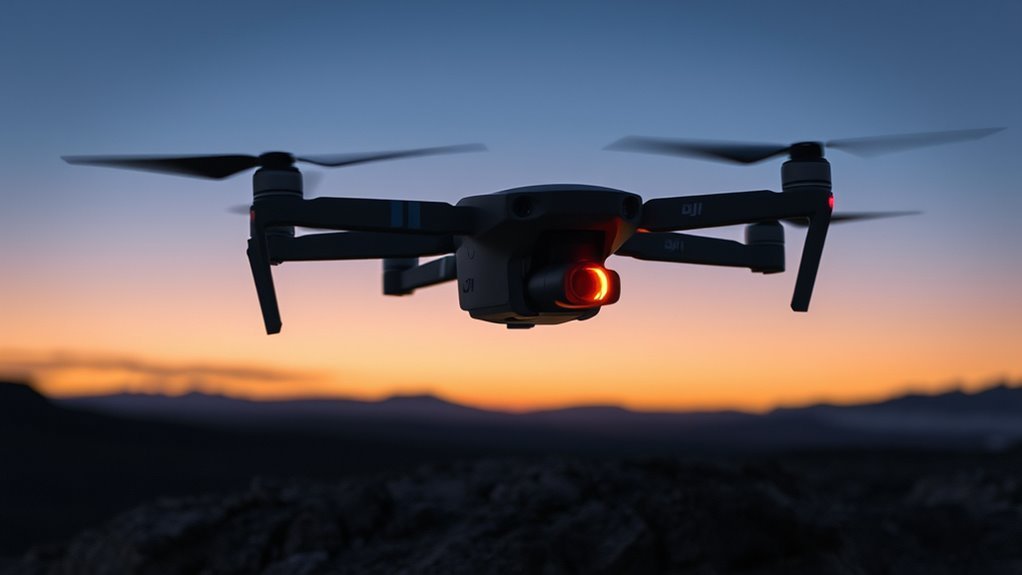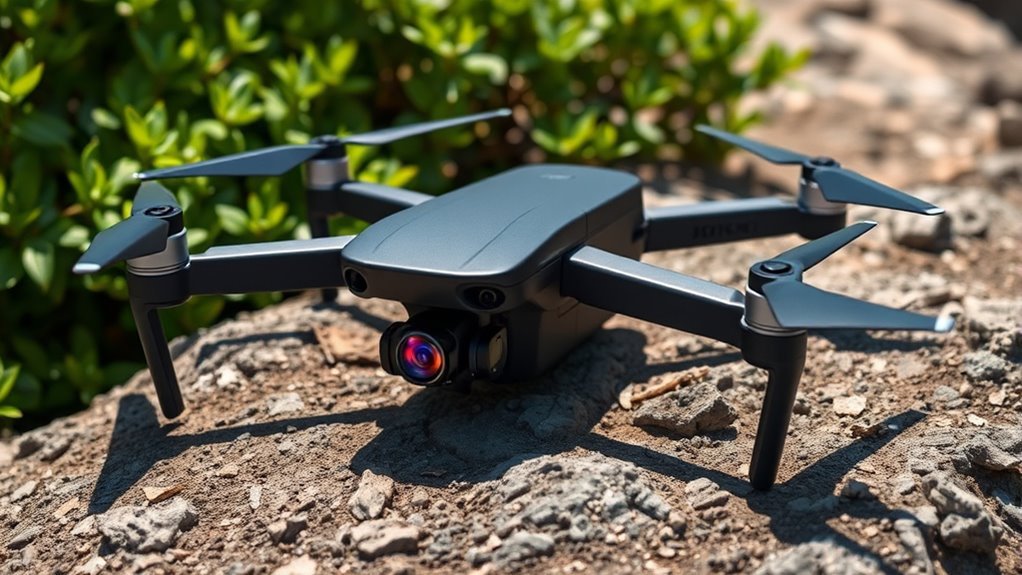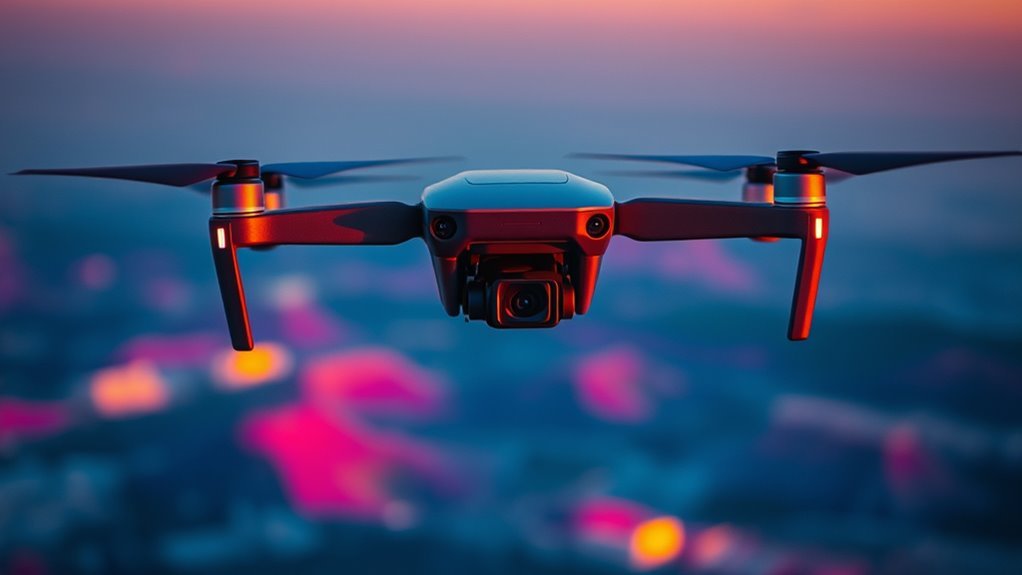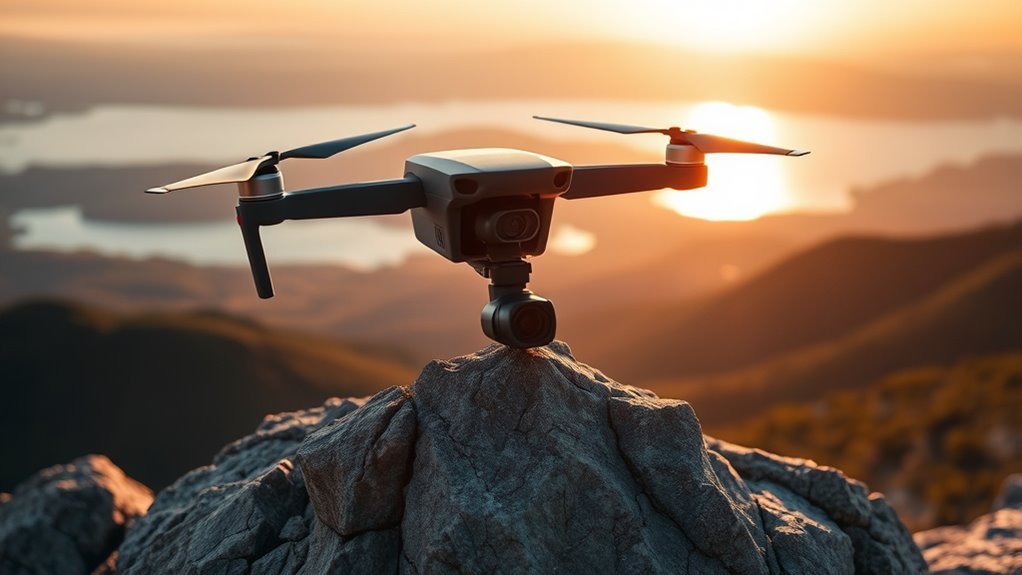You’ll find the DJI Mavic 2 Enterprise Dual offers precise thermal imaging with its FLIR sensor detecting temperature variations to 0.05°C, paired with a 12MP RGB camera capturing 4K video. Its durable, weather-resistant build handles field conditions well, while a 31-minute battery supports extended missions. The intuitive controller and safety features like obstacle avoidance enhance usability. Although battery life and extreme weather sensitivity limit some operations, its dual-sensor integration suits varied professional tasks. Exploring further reveals deeper insights into its technical strengths and practical uses.
Overview of the DJI Mavic 2 Enterprise Dual

Although primarily designed for professional use, the DJI Mavic 2 Enterprise Dual offers you a compact and versatile drone equipped with both a high-resolution RGB camera and a thermal imaging sensor. These Mavic features enable you to capture detailed visual and thermal data simultaneously, vital for Enterprise applications such as search and rescue, infrastructure inspection, and firefighting. The drone’s ability to overlay thermal images on standard visuals provides enhanced situational awareness, allowing you to identify heat signatures with precision. You’ll also benefit from advanced flight modes and obstacle avoidance systems that guarantee stable, safe operation in complex environments. This combination of technology and portability gives you the freedom to perform detailed inspections and surveys efficiently, maximizing productivity in demanding professional fields.
Design and Build Quality

You’ll notice the Mavic 2 Enterprise Dual features a compact and durable frame designed to withstand demanding environments. Its materials and construction provide structural integrity without adding unnecessary weight. Additionally, the drone includes weather-resistant elements that help maintain performance in various conditions.
Compact and Durable Frame
The Dji Mavic 2 Enterprise Dual features a compact frame engineered to withstand rigorous field conditions without compromising portability. Its compact portability allows you to easily transport the drone, fitting it into backpacks or small cases without hassle. The rugged design incorporates high-strength materials that resist impacts and scratches, ensuring durability during demanding operations. You’ll appreciate the solid hinge mechanisms and reinforced arms that maintain structural integrity even after repeated deployments. This frame balances lightweight construction with robust engineering, providing you with a reliable tool that won’t weigh you down. Whether you’re maneuvering through tight spaces or rough terrain, the Mavic 2 Enterprise Dual’s durable frame supports your freedom to operate confidently in diverse environments.
Weather Resistance Features
Building on its robust and compact frame, the Mavic 2 Enterprise Dual is engineered to endure various weather conditions, enhancing its operational reliability. Its weather resistance is achieved through sealed motor housings and protected electronic components, reducing vulnerability to moisture and dust ingress. This design guarantees consistent performance in light rain, fog, and dusty environments, crucial for uninterrupted field operations. The drone’s materials contribute substantially to overall drone durability, with corrosion-resistant alloys and reinforced plastics maintaining structural integrity under stress. While not fully waterproof, its resilience against environmental factors allows you to operate confidently across diverse settings. This balance of weather resistance and lightweight construction preserves flight efficiency without compromising durability, empowering you to explore freely and dependably.
Thermal Imaging Capabilities

Thermal imaging technology in the DJI Mavic 2 Enterprise Dual offers precise temperature measurement with its integrated FLIR thermal sensor, capable of detecting temperature differences as small as 0.05°C. This level of thermal detection enables you to identify heat variations accurately, critical for diverse imaging applications like search and rescue, infrastructure inspection, and firefighting. The drone’s thermal sensor captures detailed heat signatures, allowing you to analyze temperature anomalies in real time. Its dual-sensor system fuses thermal and visual data, enhancing situational awareness without sacrificing image clarity. This integration guarantees you maintain operational freedom while accessing reliable thermal insights, essential for informed decision-making in complex environments. Overall, the Mavic 2 Enterprise Dual’s thermal imaging capabilities deliver high precision and versatility suited for professional-grade applications.
Camera and Sensor Specifications
You’ll find the Mavic 2 Enterprise Dual equipped with a FLIR thermal sensor boasting a resolution of 160×120 pixels, ideal for detecting heat signatures in various environments. Its visual camera features a 12-megapixel CMOS sensor with a 1/2.3-inch size, delivering sharp images and 4K video at 30fps. Together, these sensors offer reliable performance metrics, including a temperature measurement range of -10°C to 400°C and efficient data fusion for enhanced situational awareness.
Thermal Imaging Capabilities
The Mavic 2 Enterprise Dual is equipped with a FLIR thermal sensor that captures temperature data with a resolution of 160 x 120 pixels, enabling precise heat detection in various environments. This resolution supports diverse thermal imaging applications, allowing you to identify heat signatures with accuracy. The drone employs advanced thermal analysis techniques to differentiate temperature ranges, enhancing situational awareness in critical operations.
Key thermal imaging features include:
- Radiometric thermal data output for accurate temperature measurement.
- Adjustable temperature scale to optimize thermal contrast.
- Real-time thermal overlay on visual imagery for enhanced interpretation.
These capabilities let you conduct detailed inspections, monitor equipment, and perform search and rescue missions without restrictions, leveraging thermal technology for operational freedom and reliability.
Visual Camera Features
Beyond its thermal imaging prowess, the Mavic 2 Enterprise Dual integrates a high-resolution visual camera designed to complement thermal data with clear, detailed imagery. This 12-megapixel camera features a 1/2.3-inch CMOS sensor, offering excellent visual clarity for capturing sharp photos and smooth 4K video at 30fps. The camera employs a mechanical shutter, eliminating rolling shutter distortion during fast motion or rapid maneuvers, which enhances image accuracy. Additionally, the drone incorporates a 3-axis gimbal for precise image stabilization, ensuring steady footage even in turbulent conditions. This combination of sensor quality and stabilization allows you to obtain reliable photographic evidence and situational awareness. The camera’s field of view balances breadth and detail, supporting missions where freedom of movement and image fidelity are paramount.
Sensor Performance Metrics
Understanding the sensor performance metrics is essential when evaluating the Mavic 2 Enterprise Dual’s capabilities. This drone combines a high-resolution visual camera with a thermal sensor, offering precise data for diverse applications. The sensor accuracy guarantees reliable detection and measurement, critical for tasks requiring detailed thermal imaging. Temperature sensitivity plays a pivotal role, allowing you to discern subtle thermal variations in challenging environments. Key specifications include:
- A 640×512 px thermal sensor with a sensitivity of <50 mK, delivering sharp thermal contrast.
- A 12 MP visual camera equipped with a 1/2.3″ CMOS sensor, capturing detailed imagery.
- Radiometric thermal imaging capability, enabling precise temperature measurement at each pixel.
These metrics provide you with freedom to perform inspections, search and rescue, or industrial monitoring with confidence and precision.
Flight Performance and Battery Life
Although the Mavic 2 Enterprise Dual is designed for professional use, you’ll find its flight performance both stable and responsive under various conditions. The drone’s advanced flight control system guarantees precise maneuvering and excellent flight stability, even in moderate winds up to 38 km/h. This reliability allows you to confidently capture thermal and visual data without interruption. Regarding battery longevity, the 3850 mAh LiPo battery delivers up to 31 minutes of flight time under ideal conditions. Real-world usage typically yields around 25-28 minutes, depending on payload and environmental factors. This balance between flight duration and stability gives you the freedom to complete extended missions efficiently, minimizing downtime. Overall, the Mavic 2 Enterprise Dual combines robust flight characteristics with sufficient battery endurance for demanding operational needs.
Control and User Interface
The Mavic 2 Enterprise Dual offers a streamlined control system that integrates both traditional remote inputs and customizable software features. This combination enhances your user experience by providing precise command over drone functions while maintaining intuitive interface design. The controller’s ergonomic layout guarantees comfort during extended operations, and the integrated display delivers real-time telemetry and thermal data without clutter.
Key elements of the control and user interface include:
- Customizable shortcut buttons for rapid access to essential functions
- Dual-band transmission supporting stable, low-latency video feeds
- A modular interface allowing you to tailor the software controls to mission-specific requirements
These features collectively empower you with freedom in maneuverability and information management, optimizing operational efficiency in diverse environments.
Safety Features and Compliance
Alongside its advanced control system, the Mavic 2 Enterprise Dual incorporates a suite of safety features designed to guarantee secure operation and regulatory compliance. You’ll appreciate its adherence to strict safety regulations and compliance standards, ensuring your flights stay lawful and risk-free. Key features include obstacle avoidance sensors, GPS-based geofencing, and automatic return-to-home functions that activate under signal loss or low battery.
| Safety Feature | Description |
|---|---|
| Obstacle Avoidance | Detects and avoids obstacles in flight path |
| Geofencing | Restricts flights within approved zones |
| Return-to-Home (RTH) | Automatically returns drone to launch point |
These measures provide you operational freedom while respecting legal frameworks, delivering both safety and compliance.
Applications and Use Cases
When you need reliable aerial data in challenging environments, the Mavic 2 Enterprise Dual offers versatile applications across industries. Its integrated thermal and visual sensors enable critical operations like search and rescue, firefighting support, and infrastructure inspection. You can extend your operational freedom while obtaining precise thermal readings and high-resolution imagery.
Key applications include:
- Disaster response and security surveillance: Quickly assess damage and monitor threats in real time.
- Agricultural assessment and wildlife monitoring: Track crop health and animal populations with thermal insights.
- Environmental research and infrastructure inspection: Detect anomalies in power lines, pipelines, or natural habitats efficiently.
This drone empowers you to gather actionable intelligence, even in low-visibility or hazardous conditions, enhancing decision-making across diverse professional fields.
Pros and Cons Analysis
Understanding the practical benefits and limitations of the Mavic 2 Enterprise Dual is key to evaluating its suitability for your specific needs. User feedback highlights its robust thermal imaging capabilities combined with high-resolution RGB sensors, enabling efficient inspections and search operations. The drone’s modular design and compact form provide operational freedom and ease of deployment. However, battery life constraints and sensitivity to extreme weather conditions can limit extended missions. In a competitive comparison, it stands out for its dual-sensor integration but may lag behind specialized thermal drones in range and image clarity. If your work demands versatile, quick deployment with solid thermal capabilities, it fits well; yet, assess if its limitations align with your operational environment before committing.

